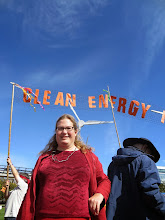California has been quite successful at encouraging the development of (1) large utility-scale renewables through the renewables portfolio standard (RPS) and other measures and (2) small-scale, single structure solar generation through the California Solar Initiative (CSI) and measures such as net energy metering (NEM). However, there have been numerous market and regulatory barriers to developing and deploying the “in-between” community-scale and neighborhood-scalerenewables that hold substantial promise.
Community-scale and neighborhood-scale distributed generation (DG) includes some technologies that simply are not cost-effective at the small scale of a single house or business, but are not large enough to justify the transaction costs of participating in the larger wholesale electricity market. These resources, such as “community solar gardens”, can meet the demands of many customers who cannot take advantage of adding renewables at their location and can also reduce investment in expensive new transmission projects. Examples of these types of projects are parking structure-scale solar photovoltaics, solar-thermal generation and space cooling, and biogas and biomass projects, some of which could provide district heating. Technology costs are falling so rapidly that these mid-scale projects are becoming competitive with utility-scale resources when transmission cost savings are factored in. SB 43 (Wolk 2013) recognizes that the promise of mid-scale renewables has not been realized.


No comments:
Post a Comment